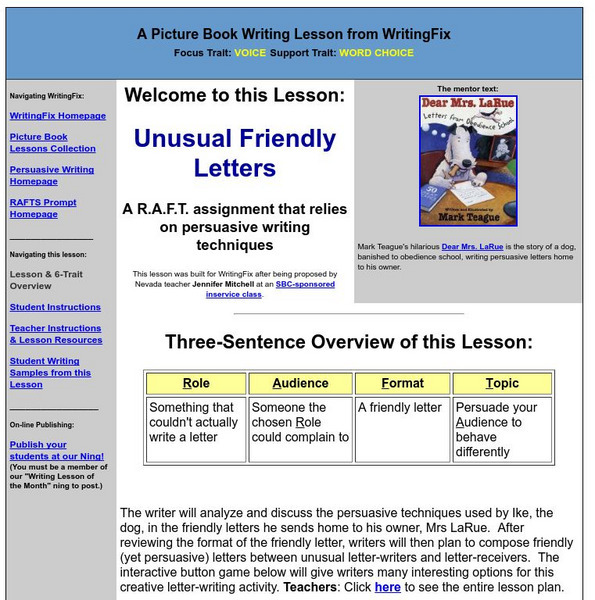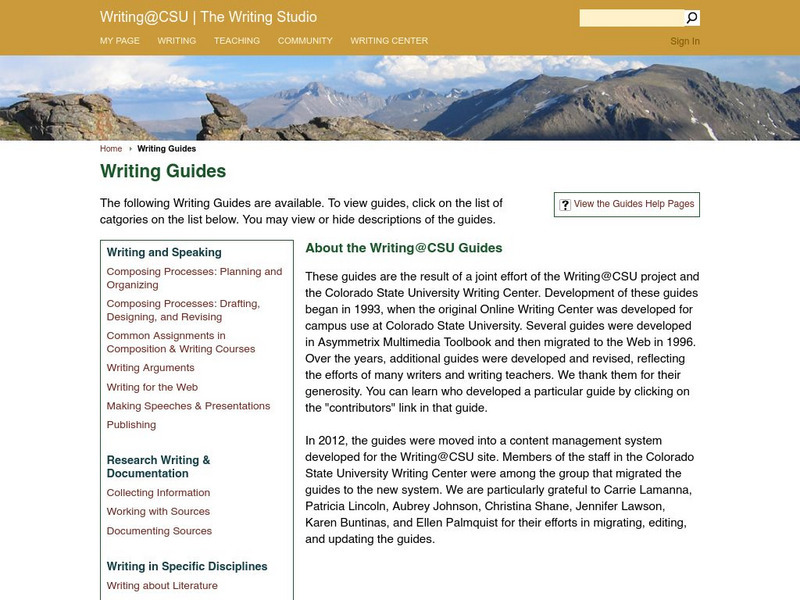Sophia Learning
Sophia: Argumentative Essays
This tutorial focuses on argumentative essays, longer writings on a well-researched topic with the writer arguing one side of the topic, free of fallacies, and providing several claims. A short YouTube clip of Monty Python shows the...
Rutgers University
Rutgers University: Getting an a on an English Paper
Written by a college professor, this site discusses five areas for students to work on to improve their writing. The areas are Thesis, Research, Close Reading, Style, and Mechanics. The author is clear and concise in his advice, and...
Texas Education Agency
Texas Gateway: Write Literary Text Using Strategies to Enhance Style & Tone
A learning module that teaches students about using literary devices to enhance style and tone in four lessons: Introduction, Style in Literature, Tone, and Your Turn.
Texas Education Agency
Texas Gateway: Tone, Style, and Figurative Language: Practice 5
A learning module that teaches students about tone, style, and figurative language in five mini-lessons: Introduction, Identifying Diction Indicating Tone, Identifying Figurative Language, Spotting Jarring Departures from Tone in Diction...
Joe Landsberger
Study Guides & Strategies: Writing Basics
A fairly detailed list of steps to take, with descriptions of those steps, in order to write a good essay.
Online Writing Lab at Purdue University
Purdue University Owl: Fiction Writing Basics
This resource discusses some terms and techniques that are useful to the beginning and intermediate fiction writer, and to instructors who are teaching fiction at these levels. W.11-12.3a Narratives
Online Writing Lab at Purdue University
Purdue University Owl: Academic Writing: Levels of Formality
Basic information explaining how the context, i.e., the audience and your purpose, determines whether you should use formal, semi-formal, or informal language. The links on the sidebar provide much more information about formal academic...
Writing Fix
Writing Fix: Unusual Friendly Letters: Persuasive Writing Techniques
In this instructional activity, students will use active voice in regards to persuasion. Lesson incorporates the A R.A.F.T. strategy: role, audience, format, topic.
Writing Fix
Writing Fix: Learning to Punctuate Direct Addresses in a Voice Filled Story
In this lesson, students will create a persuasive narrative by correctly incorporating interjections and imperative commands.
Writing Fix
Writing Fix: Don't Eat Me Monologues
In this lesson plan, students will create a 5-part (introduction, 3 ideas, conclusion) monologue incorporating persuasive techniques and strong word choice.
Grammarly
Grammarly Handbook: Informalities
A list of style techniques (with examples) used to create an informal tone in a written piece.
Other
Storyarts: The on Line Writing Workshop
Storyarts is a free online writing workshop that includes not only assignments, but also publication of writings to other e-mail subscribers through its Storyarts Listserv. Samples of published works are included.
Other
Georgia Perimeter: Choosing and Writing for an Audience
This resource goes extensively into the importance of establishing an audience when writing. It also defines types, how to choose, and how to write for an audience.
Other
Write Away: Finding Your Voice
This article, written by a college creative writing instructor, gives advice about developing a writer's voice. There are six sections with specific suggestions for improving your writing. While the source of this page is a site about...
Houghton Mifflin Harcourt
Holt, Rinehart and Winston: Grade 8: Writing a Persuasive Essay [Pdf]
Provides a student model of a persuasive essay on the topic of television violence. Allows students to examine content, format, and structure and includes notes and annotations as student aids throughout.
Other
National Writing Project
The National Writing Project site offers online articles as well as abstracts and reviews of books on such topics as teaching writing, teaching reading, encouraging writing, being a writer and standards and assessment.
Grammarly
Grammarly Handbook: Sentence Style
A list of three techniques used to develop sentence style: Sentence Variety, Sentence Emphasis, and Wordiness. Each technique links to more information.
Other
Grays Harbor College: Writing Essays: Four Tips
This resource explores four tips for writers: "Center Your Thinking," "Organize Your Thinking," "Specify Your Thoughts," and "Present Your Thoughts Clearly." The information is presented in an easy-to-follow outline with examples given...
Other
The Writing Conference, Inc.: Writing Contest
This site explains the basics for the writing contest, which is open to all students. There are contests in poetry, narration, and exposition. The topic is the same for all three forms and links are provided for the judging criteria.
Colorado State University
Colorado State University: Writing @ Csu Writing Guides
This is a fairly sophisticated series of writing guides. It assumes that users already have a solid grasp of spelling, grammar and mechanics, so it focuses more on organization and types of presentation than on more basic skills....
Grammarly
Grammarly Blog: How to Write Better Essays: 5 Concepts You Must Master
This blog article discusses essay writing including thesis development, strong form, style, conventions, and support and references.
Grammarly
Grammarly Blog: Consistent Point of View
This Grammarly Handbook resource reminds students how to write with a consistent point of view. Examples are provided to demonstrate how to fix a sentence that contains an inconsistent point of view.
Grammarly
Grammarly Blog: When Should I Spell Out Numbers?
This page focuses on when to write figures and numbers in writing; it provides the rules for both general writing and for technical, scientific, and complex writing. Examples are provided.
Grammarly
Grammarly Blog: Italics and Underlining: Names Ships and Trains
An explanation and examples using italics/underlining when writing the names of spacecraft, aircraft, ships, and trains.














![Holt, Rinehart and Winston: Grade 8: Writing a Persuasive Essay [Pdf] Handout Holt, Rinehart and Winston: Grade 8: Writing a Persuasive Essay [Pdf] Handout](http://content.lessonplanet.com/resources/thumbnails/410031/large/bwluav9tywdpy2symdiwmduymc0zmdmzos0xnwrwzjdwlmpwzw.jpg?1589984947)






